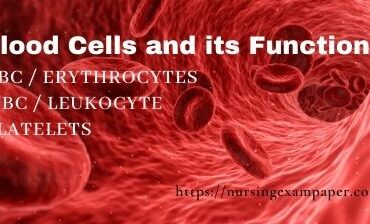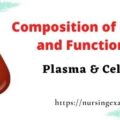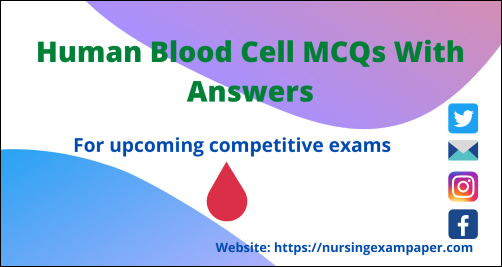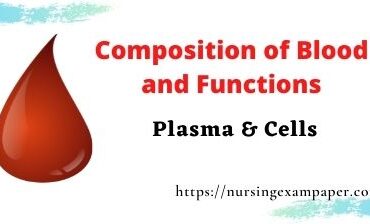There are three types of cells present in the blood. That are (1) RBC / ERYTHROCYTES (2) WBC / LEUKOCYTES (3) PLATELETS
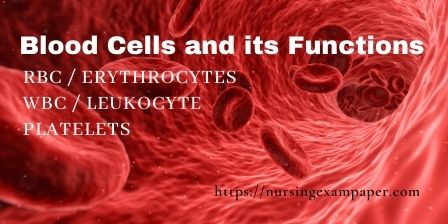
Red Blood Cells / Erythrocytes And Its Functions
4.7 to 6.1 million (males) 4.2 to 5.4 million (females)
- RBC also called erythrocyte, the red color of blood is due to red blood cells because RBC contains hemoglobin, one RBC contains 280 million Hb molecule.
- hemoglobin is a red iron-rich protein that binds oxygen. the red color of Hb is due to porphyrin pigment. 1 gm Hb contains 3.34 mg iron.
- Mature RBC is small, round and biconcave in shape.
- Nucleus absent in RBC.
- RBC covered by a membrane composed of lipid and proteins.
- The diameter of RBC is 7.2 µm.
- The normal life span of RBC is 120 days.
- RBC develops in bone marrow in adulthood and in embryonic life, RBC develops in the yolk sac and in fetal life RBC develops mainly in spleen, liver, and thymus.
- It destroys in the spleen, so the spleen is called graveyard of RBC.
- Normal RBC count is 4.7 to 6.1 mcl and normal count in children- 4.0 to 5.5 mcl.
- Production of RBC is called erythropoiesis, kidney hormone erythropoietin helps in the production of RBC.
Components of Blood and Functions
White Blood Cells / Leukocytes
WBC is also called leukocyte. Nucleus present in White Blood Cells, dead WBC called pus. Normal white blood counts are 4000 to 10000. the life span of WBC is depended on their work and demand. WBC was further divided into two groups. (1) Granular leukocyte (2) Agranular leukocyte. WBCs concentration is decreased below the lower limit is called leukemia.
(1) Granular leukocyte –
Granules present in the cytoplasm of granulocytes, granules have an enzyme (ex. proteases) that destroy the microorganism. three granulocytes present in WBC are following.
- Eosinophil – diameter of eosinophil is 10 to 14 µm. it seems red-orange color after staining with acidic dye (eosin), eosinophil plays important role in allergy and parasitic infection ex. malaria.
- Basophil – Diameter of basophil is 8 to 10 µm, it seems blue-purple color after staining with basic dye (methylene blue). Play important role in healing process.
- Neutrophil – Diameter of neutrophil is 10 to 12 µm, it seems violet color after staining with both dye (eosin+methylene blue=leishman’s stain). It provides first line defense. Old neutrophil called polymorphonuclear leukocyte, because its nucleus has 2-5 lobes and the young neutrophil called bands because its nucleus seems like a Rod.
(2) Agranular leukocytes –
Lymphocyte –
Blood MCQs – Question For Nursing Exam
The diameter of the lymphocyte is 7 to 12µm. Lymphocytes blood cells are divided into two types according to work and formation. (i)T lymphocyte (ii)B lymphocyte.
(i) T lymphocyte – Its final maturation is held in the thymus gland so it is called T lymphocyte. T-lymphocytes are responsible for cellular immunity. T lymphocyte divided into four cells these are following –
- Helper T cells or CD4+ or inducer T cells– During any infection helper T cells stimulate other cells, normal count of CD4+ cells are 500 to 1500 cells/mm3 (average 950 mm3). if CD4+ count decrease below 200 mm3 than it indicates AIDS.
- Cytotoxic T cells or killer cells or CD8+ cells– These cells attack directly to microorganism during infection.
- Suppress T lymphocyte – These cells decreases the activity of killer cells.
- Memory T lymphocyte – These cells present in lymphoid tissue, these cells prevents the same infection in the future.
(ii) B lymphocyte – Its final maturation is held in Bone marrow (after birth) and during fetal life, it matures in the liver so these cells are called B lymphocytes. B lymphocyte responsible for Humoral immunity or B cells immunity. Humoral immunity means immunity that produces from antibodies and immunoglobulin. B lymphocyte divided into two groups are-
A. Plasma cells- Plasma cells produce 5 types of immunoglobulin or antibodies.
- IgA – IgA presents in breast milk, sweat, tear, and saliva.
- IgG – IgG is the most common type of immunoglobulin, it founds approximately 80%. IgG only can cross the placenta, it indicates chronic infection.
- IgM – After any infection plasma cells secrets first IgM, it indicates acute infection.
- IgE – It involves allergic and hypersensitivity.
- IgD – it is less in numbers and less important.
Monocyte –
Its diameter is 14 to 18µm. It is the largest WBC cell. Monocyte migrates blood to tissue and produces macrophages. Macrophages are divided into two types.
Fixed Macrophage and Wandering Macrophage.
Fixed macrophage – Some macrophages stay fixed in any special tissue. Ex- Kupffer cells (A phagocytic cell that forms the lining of the sinusoids of the liver and is involved in the breakdown of red blood cells.) and alveolar cells in the Lungs.
Wandering macrophage – These macrophages are movable from one to another organ, the so-called wandering macrophage.
Aiims Mock Test Paper For Staff Nurse
Platelets or Thrombocytes
Normal platelets counts are 1,50,000 – 500,000.
- Low platelet concentration is Thrombocytopenia.
- Elevated platelet concentration is Thrombocytosis.
- Thrombocytes are not complete cells, it develops from divination of a megakaryocyte into 2000 to 3000 parts.
- Platelets are colorless and disc-shaped cells.
- Platelet does not have Nucleus.
- Diameter is 2 to 4µm and its volume is 7.5 cubic micron (µm3).
- Platelets are responsible for control blood loss from damaged blood vessels. By formation of a clot within an intact vessel.
- Thrombocytes have three important properties-1.Adhesiveness 2. Aggregation 3. Agglutination.
Its life span is 5 to 9 days. - Dead platelets or thrombocytes are destroyed by fixed macrophages in Liver and Spleen.
